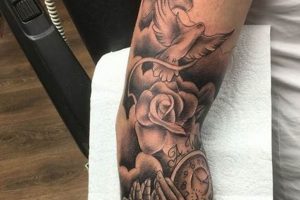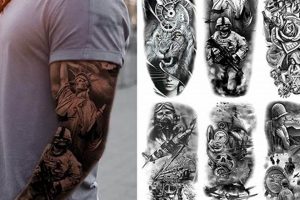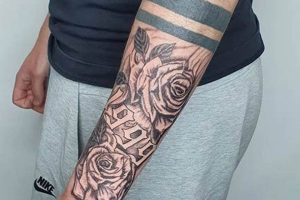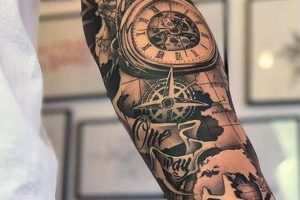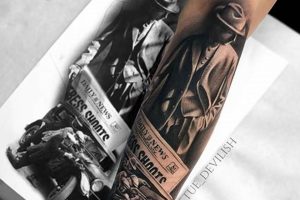Tattoos encompassing a full arm, often referred to as sleeves, can draw inspiration from indigenous cultures. Such designs typically incorporate symbolic elements like animals, spiritual figures, geometric patterns, and traditional tools or weaponry specific to a particular heritage. For example, a Polynesian-inspired sleeve might feature depictions of sea turtles, spearheads, and stylized waves, while a sleeve inspired by Northwest Coast Native American cultures could incorporate images of ravens, orcas, and formline art.
Representing a significant commitment due to their size and visibility, full-arm tattoos offer a powerful medium for expressing cultural pride and personal narratives. Historically, tattoos held deep cultural significance, serving as markers of identity, status, and spiritual beliefs within indigenous communities. Contemporary interpretations allow individuals to connect with their ancestry, honor their heritage, or showcase admiration for a specific indigenous culture. Carefully researched and respectfully executed designs can contribute to the preservation and appreciation of these rich artistic traditions.
Exploring specific cultural inspirations, design considerations, and the importance of working with knowledgeable artists are essential steps in the process of developing a meaningful and aesthetically compelling tattoo sleeve. Understanding the symbolism behind chosen imagery and engaging in respectful dialogue with cultural representatives where appropriate ensures that the final piece honors the intended heritage authentically.
Tips for Designing Culturally Sensitive Tattoo Sleeves
Developing a meaningful and respectful tattoo sleeve requires careful planning and consideration, particularly when drawing inspiration from indigenous cultures. These tips offer guidance for navigating the process responsibly.
Tip 1: Thorough Research is Paramount: Deeply investigate the specific indigenous culture serving as inspiration. Understand the historical and cultural context of relevant symbols, patterns, and artistic styles.
Tip 2: Engage with Cultural Experts: Seek guidance from individuals belonging to the culture inspiring the design. Direct dialogue can provide invaluable insights and ensure respectful representation.
Tip 3: Prioritize Authentic Representation: Avoid appropriating sacred or culturally sensitive imagery. Focus on designs that celebrate and honor the heritage respectfully.
Tip 4: Choose a Skilled and Knowledgeable Artist: Select a tattoo artist with experience in the specific style and cultural nuances of the chosen design. Review their portfolio to ensure their expertise aligns with the project’s goals.
Tip 5: Consider Placement and Composition: Thoughtfully plan the placement of elements within the sleeve, considering the body’s natural contours and how the design will flow visually.
Tip 6: Plan for Long-Term Commitment: Recognize the permanence of tattoos. Ensure the chosen design remains meaningful and relevant over time.
Tip 7: Embrace the Collaborative Process: Open communication with the chosen artist is crucial. Share research findings and discuss design ideas to ensure a collaborative and respectful outcome.
Careful consideration of these factors contributes to a well-executed, culturally sensitive, and personally meaningful tattoo sleeve that honors the chosen inspiration respectfully.
By following these guidelines, individuals can embark on the journey of creating a tattoo sleeve that serves as a powerful testament to cultural appreciation and personal expression.
1. Cultural Significance
Cultural significance forms the foundation of meaningful native-inspired tattoo sleeves. Designs divorced from cultural context risk trivializing rich traditions and complex symbolism. Authenticity stems from understanding the historical and spiritual importance of chosen elements. For instance, incorporating a Maori T moko design without understanding its genealogical ties and traditional application methods constitutes cultural appropriation. Conversely, a sleeve inspired by Anishinaabe floral patterns, researched meticulously and executed in collaboration with a knowledgeable artist, can celebrate heritage while fostering cultural appreciation. The connection between design and cultural meaning elevates the tattoo beyond mere aesthetics, transforming it into a powerful statement of identity and respect.
The process of imbuing a tattoo sleeve with cultural significance necessitates engagement with the source culture. Consulting cultural advisors, researching historical records, and understanding the evolving nature of traditions are essential steps. A sleeve inspired by Polynesian navigation, for example, might incorporate star constellations and traditional wayfinding symbols, reflecting not only ancestral knowledge but also the ongoing connection between people and the ocean. This depth of understanding adds layers of meaning, transforming the tattoo into a wearable narrative that honors cultural heritage.
Successfully integrating cultural significance into tattoo designs requires a balance between personal expression and respectful representation. Challenges include navigating the complexities of cultural appropriation, ensuring accurate portrayal of symbolic elements, and finding skilled artists capable of executing culturally sensitive designs. Ultimately, the pursuit of culturally significant tattoo sleeves fosters intercultural dialogue, promotes artistic exchange, and allows individuals to connect with their heritage in a deeply meaningful way.
2. Symbolic Imagery
Symbolic imagery forms the core of native tattoo sleeve ideas, imbuing the designs with cultural narratives, spiritual beliefs, and personal meaning. Understanding the symbolism within a specific cultural context is crucial for creating a respectful and resonant piece. Each element, from animals and plants to geometric patterns and ancestral figures, carries a weight of meaning that contributes to the overall narrative of the tattoo.
- Animals as Emblems
Animals frequently feature in indigenous tattoo traditions, representing specific qualities or embodying spiritual significance. A bear, for example, might symbolize strength and protection in some cultures, while a raven could represent wisdom or transformation. Choosing an animal and understanding its cultural relevance is essential for incorporating its symbolic power into the sleeve design.
- Ancestral Figures and Deities
Representations of ancestors or deities connect the wearer to their lineage and spiritual beliefs. These figures can embody cultural values, historical narratives, or protective forces. Incorporating such imagery requires deep respect and understanding of the cultural context to avoid misrepresentation or appropriation.
- Geometric Patterns and Shapes
Geometric patterns often hold significant meaning within indigenous art traditions. Specific shapes and arrangements can represent natural elements, cosmological beliefs, or social structures. Researching the specific cultural meaning of these patterns is crucial for incorporating them respectfully into a sleeve design.
- Nature-Inspired Elements
Elements from the natural world, such as plants, water, or celestial bodies, frequently appear in native tattoo designs. These elements can symbolize interconnectedness with the environment, spiritual growth, or the cyclical nature of life. Understanding the specific cultural associations of these elements is crucial for conveying intended meanings.
The careful selection and placement of symbolic imagery within a native tattoo sleeve transforms the design into a powerful storytelling medium. The combined elements create a visual narrative that reflects cultural heritage, personal beliefs, and a deep connection to ancestral traditions. Ultimately, the symbolic resonance of the imagery elevates the tattoo beyond mere decoration, imbuing it with lasting meaning and cultural significance.
3. Artist Selection
Artist selection holds paramount importance when realizing native tattoo sleeve ideas. The chosen artist’s skill, cultural understanding, and artistic sensibility directly impact the final result. Collaborating with an artist experienced in indigenous art styles ensures accurate representation and respectful handling of cultural imagery. Technical expertise in executing intricate designs, such as the fine lines of Polynesian tattoos or the bold forms of Northwest Coast art, is essential for achieving a visually compelling and culturally sensitive piece. Choosing an artist unfamiliar with these nuances can lead to misrepresentation, cultural appropriation, and an aesthetically unsatisfactory outcome. For example, a Haida sleeve demands an artist familiar with formline design principles; entrusting such a project to an artist inexperienced in this style could result in a visually inaccurate and culturally insensitive tattoo.
Beyond technical skill, a deep understanding of the cultural context is crucial. An artist specializing in indigenous tattooing possesses knowledge of symbolism, historical significance, and traditional techniques. This cultural sensitivity ensures the design remains respectful and authentic. For instance, an artist specializing in Maori T moko understands the sacred nature of these tattoos and their connection to genealogy and identity, ensuring the design’s cultural integrity. Conversely, an artist lacking this cultural understanding might inadvertently incorporate inappropriate elements or misrepresent traditional motifs.
Finding the right artist requires thorough research and careful consideration. Reviewing portfolios, seeking recommendations within indigenous communities, and engaging in open dialogue with potential artists are essential steps. This process ensures the selected artist possesses both the technical expertise and the cultural sensitivity necessary to execute a meaningful and respectful native tattoo sleeve. The artist becomes a collaborator, contributing artistic skill and cultural understanding to realize a design that honors heritage and personal expression authentically. This collaborative approach safeguards against cultural appropriation, promoting respectful representation and ensuring the final piece holds both aesthetic and cultural value.
4. Placement and Flow
Placement and flow are critical design elements in native tattoo sleeves, impacting both the aesthetic appeal and the narrative conveyed. The arrangement of individual elements across the curvature of the arm determines how the eye moves across the design, shaping the viewer’s interpretation and the wearer’s experience. Thoughtful placement and flow enhance the storytelling potential of the tattoo, creating a cohesive and visually dynamic composition that complements the body’s natural contours.
- Body Contours and Natural Lines
Consideration of the body’s natural lines is paramount. Designs should flow harmoniously with the musculature and curves of the arm, enhancing rather than disrupting the body’s form. For example, a Polynesian-inspired sleeve might incorporate wave patterns that follow the contours of the biceps and forearm, creating a sense of fluid movement.
- Visual Hierarchy and Focal Points
Placement establishes visual hierarchy, guiding the viewer’s eye through the design. Larger, more prominent elements typically serve as focal points, while smaller details contribute to the overall narrative. A Northwest Coast sleeve might feature a dominant image of a bear on the shoulder, with supporting formline designs flowing down the arm, creating a clear focal point and a sense of visual balance.
- Storytelling and Narrative Progression
Placement and flow can enhance the storytelling potential of the tattoo. Elements can be arranged to create a chronological narrative or to emphasize symbolic relationships. A sleeve depicting a creation myth might place the foundational elements near the shoulder, with subsequent events unfolding down the arm, creating a visual timeline of the narrative.
- Balance and Composition
A well-balanced composition ensures visual harmony. Distributing elements evenly across the arm prevents overcrowding and allows each element to stand out. Incorporating negative space strategically provides visual breathing room and emphasizes the intricate details of the design. This balance ensures the tattoo remains aesthetically pleasing and avoids a cluttered or overwhelming appearance.
Successful placement and flow transform a collection of individual elements into a unified and dynamic composition. The interplay of these factors elevates the native tattoo sleeve, enhancing its visual impact and strengthening its narrative power. The result is a wearable work of art that embodies cultural significance, personal meaning, and aesthetic excellence.
5. Long-Term Relevance
Long-term relevance is a crucial consideration when developing native tattoo sleeve ideas. Given the permanence of tattoos, designs should resonate deeply and retain their significance over time. Trends and fleeting interests should be avoided in favor of imagery grounded in enduring cultural values, personal narratives, and ancestral connections. A sleeve rooted in superficial trends risks becoming a source of regret, while one deeply connected to personal heritage and cultural understanding remains a powerful symbol of identity throughout life. Consider the difference between a sleeve featuring a pop culture icon, likely to fade in relevance, and one incorporating ancestral symbols passed down through generations, retaining enduring cultural and personal meaning.
Several factors contribute to the long-term relevance of native tattoo sleeves. Careful research into the chosen culture’s history, traditions, and symbolism ensures the design’s authenticity and enduring significance. Collaboration with cultural advisors or knowledgeable artists adds depth and avoids misappropriation. Selecting imagery that holds deep personal meaning, perhaps reflecting family history or spiritual beliefs, further strengthens the tattoo’s long-term resonance. A sleeve depicting a family clan’s traditional animal totem, for example, holds greater personal significance than a generic image of the same animal, ensuring its relevance endures through changing personal circumstances and societal trends.
Ensuring long-term relevance requires a thoughtful and introspective approach to design. Individuals should consider how their chosen imagery might evolve in meaning over time and how it aligns with their core values and long-term goals. This careful consideration avoids impulsive decisions based on transient trends, resulting in a tattoo that remains a source of pride and personal significance for years to come. The enduring power of culturally grounded and personally meaningful designs ensures the native tattoo sleeve remains a potent symbol of identity, heritage, and unwavering self-expression throughout life’s journey.
Frequently Asked Questions
Addressing common queries regarding native tattoo sleeves provides clarity and guidance for those considering such designs. Open and honest engagement with these topics promotes respectful representation and informed decision-making.
Question 1: How does one ensure cultural sensitivity when choosing a native tattoo sleeve design?
Thorough research is paramount. Understanding the historical and cultural context of chosen symbols, patterns, and artistic styles is crucial. Consulting with cultural advisors or individuals belonging to the culture in question ensures respectful representation and avoids misappropriation.
Question 2: What are the ethical considerations when drawing inspiration from indigenous cultures for tattoo designs?
Avoiding the appropriation of sacred or culturally sensitive imagery is essential. Focus on designs that celebrate and honor heritage respectfully, ensuring the chosen imagery aligns with cultural values and traditions. Collaboration with indigenous artists or cultural experts demonstrates respect and ensures authenticity.
Question 3: How does one find a reputable and knowledgeable tattoo artist specializing in native art styles?
Seek recommendations within indigenous communities, review artist portfolios carefully, and engage in open dialogue with potential artists about their cultural understanding and experience. A skilled artist specializing in indigenous art styles possesses both technical expertise and cultural sensitivity.
Question 4: What are the long-term considerations for maintaining and preserving a native tattoo sleeve?
High-quality inks and proper aftercare contribute to preserving the vibrancy and integrity of the tattoo. Protecting the tattoo from excessive sun exposure and maintaining healthy skin practices ensures longevity. Consulting with the tattoo artist for specific aftercare instructions and recommendations is essential.
Question 5: How can one distinguish between cultural appreciation and cultural appropriation in tattoo design?
Appreciation involves respectful engagement with a culture’s artistic traditions, while appropriation involves taking elements out of context, often for personal gain or without proper understanding. Respectful engagement requires thorough research, collaboration, and a genuine desire to honor the culture’s heritage.
Question 6: What are the potential challenges associated with incorporating native imagery into tattoo designs?
Navigating the complexities of cultural appropriation, ensuring accurate portrayal of symbolic elements, and finding skilled artists capable of executing culturally sensitive designs present potential challenges. Open dialogue, thorough research, and respectful collaboration mitigate these challenges.
Thorough research, respectful collaboration, and a deep understanding of cultural context are crucial when considering native tattoo sleeve ideas. These practices ensure a meaningful and respectful outcome that honors indigenous heritage while expressing personal identity.
Further exploration of specific cultural traditions and artistic styles can enrich understanding and inform design choices. Engaging with indigenous artists and communities provides invaluable insights and fosters respectful cultural exchange.
Native Tattoo Sleeve Ideas
Exploring native tattoo sleeve ideas requires a multifaceted approach encompassing cultural sensitivity, symbolic representation, artistic expertise, and long-term considerations. Designs grounded in thorough research and respectful collaboration honor indigenous heritage authentically. Careful selection of symbolic imagery imbues the tattoo with deep meaning, transforming it into a powerful narrative reflecting cultural values and personal identity. Skilled artists specializing in indigenous art styles ensure accurate and aesthetically compelling execution. Thoughtful placement and flow enhance the visual impact and storytelling potential of the sleeve. Long-term relevance, rooted in enduring cultural connections and personal narratives, ensures the tattoo retains its significance throughout life’s journey.
Native tattoo sleeve ideas represent a powerful medium for expressing cultural appreciation and personal identity. However, responsible execution demands a commitment to respectful representation, ongoing learning, and genuine engagement with indigenous communities. Embracing these principles elevates the tattoo beyond mere aesthetics, transforming it into a lasting testament to cultural heritage and individual expression. Further exploration of specific cultural traditions, artistic styles, and collaboration with indigenous artists remain essential for fostering meaningful and respectful representations.



